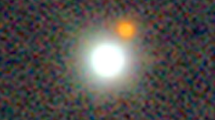Abstract
The ultraviolet broad absorption lines have been seen in the spectra of quasars at high redshift, and are generally considered to be caused by outflows with velocities from thousands kilometers per second to one tenth of the speed of light. They provide crucial implications for the cosmological structures and physical evolutions related to the feedback of active galactic nuclei (AGNs). Recently, through a dedicated program of optically spectroscopic identifications of selected quasar candidates at redshift 5 by using the Lijiang 2.4 m telescope, we discovered two luminous broad absorption line quasars (BALQSOs) at redshift about 4.75. One of them may even have the potentially highest absorption Balnicity Index (BI) ever found to date, which is remarkably characterized by its deep, broad absorption lines and sub-relativistic outflows. Further physical properties, including the metal abundances, variabilities, evolutions of the supermassive black holes (SMBH) and accretion disks associated with the feedback process, can be investigated with multi-wavelength follow-up observations in the future.
Similar content being viewed by others
References
Weymann R J, Morris S L, Foltz C B, et al. Comparisons of the emission-line and continuum properties of broad absorption line and normal quasi-stellar objects. Astrophys J, 1991, 373: 23–53
Stocke J T, Morris S L, Weymann R J, et al. The radio properties of the broad-absorption-line QSOs. Astrophys J, 1992, 396: 487–503
Hewett Paul C, Foltz Craig B. The frequency and radio properties of broad absorption line quasars. Astron J, 2003, 125: 1784–1794
Knigge C, Scaringi S, Goad M R, et al. The intrinsic fraction of broadabsorption line quasars. Mon Not R Astron Soc, 2008, 386: 1426–1435
Reichard T A, Richards G T, Hall P B, et al. Continuum and emissionline properties of broad absorption line quasars. Astron J, 2003, 126: 2594–2607
Scaringi S, Cottis C E, Knigge C, et al. Classifying broad absorption line quasars: metrics, issues and a new catalogue constructed from SDSS DR5. Mon Notic Roy Astron Soc, 2009, 399: 2231–2238
Gibson R R, Jiang L, Brandt W N, et al. A catalog of broad absorption line quasars in sloan digital sky survey data release 5. Astrophys J, 2009, 692: 758–777
Trump J R, Hall P B, Reichard T A, et al. A catalog of broad absorption line quasars from the sloan digital sky survey third data release. Astrophys J Suppl, 2006, 165: 1–18
Wu X B, Hao G, Jia Z, et al. SDSS quasars in the WISE preliminary data release and quasar candidate selection with optical/infrared colors. Astron J, 2012, 144: 49–60
Zhang J J, Wang X F, Bai J M, et al. Optical and ultraviolet observations of the narrow-lined type Ia SN 2012fr in NGC 1365. Astron J, 2014, 148: 1–15
Schlafly E, Finkbeiner D P. Measuring reddening with sloan digital sky survey stellar spectra and recalibrating SFD. Astrophys J, 2011, 737: 103–116
Yi W M, Wang F, Wu X B, et al. SDSS J013127.34-032100.1: A newly discovered radio-loud quasar at z = 5.18 with extremely high luminosity. Astrophys J Lett, 2014, 795: 29–34
Becker R H, White R L, Helfand D J. The First survey: Faint images of the radio sky at twenty centimeters. Astrophys J, 1995, 450: 559–577
Skrutskie M F, Cutri R M, Stiening R, et al. The two micron all sky survey (2MASS). Astron J, 2006, 131: 1163–1183
Wright E L, Eisenhardt P, Mainzer A K, et al. The wide-field infrared survey explorer (WISE): Mission description and initial on-orbit performance. Astron J, 2010, 140: 1868–1881
York D G, Adelman J, Anderson John E J, et al. The sloan digital sky survey: Technical summary. Astron J, 2000, 120: 1579–1587
Reichard T A, Richards G T, Schneider D P, et al. A catalog of broad absorption line quasars from the sloan digital sky survey early data release. Astron J, 2003, 125: 1711–1728
Wall J V, Jackson C A, Shaver P A, et al. The Parkes quarter-Jansky flat-spectrum sample III. Space density and evolution of QSOs. Astron Astrophys, 2005, 434: 133–148
Elvis M, Wilkes B J, McDowell J C, et al. Atlas of quasar energy distributions. Astrophys J Suppl Ser, 1994, 95: 1–68
Ganguly R, Brotherton M S. On the fraction of quasars with outflows. Astrophys J, 2008, 672: 102–107
Cattaneo A, Faber S M, Binney J. The role of black holes in galaxy formation and evolution. Nature, 2009, 460: 213–219
Ciotti L, Ostriker J P, Proga D. Feedback from central black holes in elliptical galaxies. I. Models with either radiative or mechanical feedback but not both. Astrophys J, 2009, 699: 89–104
Levine R, Gnedin N Y. AGN outflows in a cosmological context. Astrophys J, 2005, 632: 727–735
Ostriker J P, Choi E, Ciotti L, et al. Momentum driving: Which physical processes dominate active galactic nucleus feedback? Astrophys J, 2010, 722: 642–652
Scannapieco E, Oh S P. Quasar feedback: The missing link in structure formation. Astrophys J, 2004, 608: 62–79
Allen J T, Hewett P C, Maddox N, et al. A strong redshift dependence of the broad absorption line quasar fraction. Mon Not R Astron Soc, 2011, 410: 860–884
Author information
Authors and Affiliations
Corresponding author
Additional information
Recommended by MAO ShuDe (Associate Editor)
Rights and permissions
About this article
Cite this article
Yi, W., Wu, X., Wang, F. et al. Discovery of two broad absorption line quasars at redshift about 4.75 using the Lijiang 2.4 m telescope. Sci. China Phys. Mech. Astron. 58, 599501 (2015). https://doi.org/10.1007/s11433-015-5685-4
Received:
Accepted:
Published:
DOI: https://doi.org/10.1007/s11433-015-5685-4




